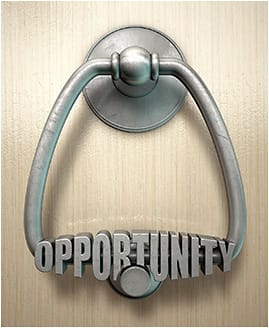Most have heard the adage “When opportunity knocks, answer.” Are multifocal contact lenses one of the opportunities knocking for both our patients and our practices? I would argue “yes,” and I explain here why we, as optometrists, should answer.
A GREAT NEED
Let’s look at the presbyopic population. Baby boomers (those born between 1946 and 1964) and the Silent Generation (those born between 1928 and 1945) are all firmly presbyopic.
The baby boomers, comprising approximately 21% of the population, were most recently taken over in numbers by Millennials, yet, as empty nesters, hold the purse strings of disposable income in the United States.1,2 This largest generation of presbyopic patients, numbering 73 million, not only have the means for improving their quality of life, they are quite a motivated bunch because they are projected to live longer, extend careers or actively retire earlier than the generation prior.3 Additionally, I have discovered that this older group of presbyopic patients enjoy travel, outdoor activities, staying fit and epitomize what it is to be “young at heart.”

Generation X (those born between 1965 and 1980), comprise approximately 20% of the population and are increasingly all in the age range of presbyopia. This group values their independence and is quite entrepreneurial, holding the distinction of comprising the highest percentage of startup founders at 55%!4 Also, these presbyopic patients are motivated by diversity and work-life balance.5
Over 47% of the 331 million folks who populate the U.S. are firmly or emergently presbyopic, totaling a whopping 155.6 million.
Next, let’s examine this population’s visual needs. Today’s presbyopic patients have high visual demands at all distances. Specifically, computer and digital device use, along with car dashboards turning into virtual cockpits, have changed the way they get their information and navigate their world.
Additionally, today’s presbyopic patients comprise 58% of the workforce (25% Baby Boomers and 33% Generation X) with digital and tech-savvy Generation Xers, and 65% of Baby Boomers planning to work past age 65.4
Further, through practice, I have found that presbyopic patients value a more youthful appearance, which contact lens wear provides.
ADVANCES
Over the years, discussions with colleagues have elicited a multitude of reasons they don’t fit multifocal contact lenses, with the top three as too much chair time, poor success and cost. As someone who fits a lot of multifocal contact lenses, I can tell you that advances have made these reasons obsolete, as discussed below:

- Too much chair time. Historically, the multifocal contact lens candidate has required education to set realistic expectations of the vision the contact lenses will provide. When providing this education at my practice, I avoid getting into the weeds with discussions on the optics of multifocal contact lenses and simply accentuate how lens features will fulfill visual needs. Once optometrists practice the verbiage they are comfortable and successful with, the discussion becomes seamless and concise. An example from my practice is: “The results from your examination today show you are an ideal candidate for multifocal contact lenses. Today’s advanced technologies can allow you to efficiently see most of your world the vast majority of the time; I have carefully chosen a great lens tailored for your vision and comfort.”
Another reason given for too much chair time is fitting. I would argue that today’s robust on-site fitting sets increasingly allow for timely fitting. Each manufacturer has performed clinical trials fitting thousands of eyes to formulate efficient fitting guides to deliver optimal success, if used. I have discovered that some seasoned O.D.s tend to be the greatest culprits of increasing chair time by utilizing strategies from past lens designs or based on the foundational optics taught, which are intuitive for fitting multifocal spectacle lenses but do not translate to multifocal contact lenses. To reduce chair time from fitting, optometrists must follow the fitting “recipe” tailored for the lens design they have chosen. - Poor success. A recent explosion of multifocal designs, including soft toric, hybrid, corneal and scleral GPs, have given optometrists enhanced options to meet patients’ visual demands and comfort. In fact, it is now rare to find a refractive error “out of parameters” for the vast majority of offerings. Also, fitting specialty contact lenses empirically has become more commonplace, and our industry partners have excellent consultants to provide fitting guidance.
The advancing age range of presbyopic patients inherently puts many at risk for dry eye disease (DED). Introducing a contact lens on an eye that has an unstable tear film can certainly bring forth issues with comfort and vision. As with the refractive and cataract surgery patient, it is important optometrists address any tear film issues by treating the ocular surface first. Thankfully, a slew of DED diagnostic devices and treatments are available to aid O.D.s in identifying and managing the chronic condition. - Cost. Some contact lenses can be less expensive than when they first became available. Also, O.D.s need to keep patient need in perspective. In this case, when educated on the benefits of multifocal contact lenses, I have found that presbyopic patients place a great deal of value on them and have the resources to enhance their quality of life. Optometrists do a great disservice to these, among other, patients when they fail to offer them all the available options. And as a brief, yet related, aside, O.D.s also do a great disservice to their businesses when their fitting fees for these lenses do not reflect the level of care and cost of goods commensurate with offering them. Fulfilling patients’ needs is what also fulfills practice needs. Optometrists should always avoid de-valuing advanced services. (See “Tips on Becoming a Heavy Fitter,” p.25.)
Tips on Becoming a Heavy Fitter
- Call on other players. To fulfill the needs of today’s presbyopic patients, optometrists need timely resources in place to efficiently fit patients. Just as O.D.s utilize different designs to optimize vision with presbyopic spectacle lenses, they need to have a healthy familiarity with the designs of multifocal contact lenses. With all the advances in lens designs and materials, this can seem daunting, but we all have a great resource in the expertise of trusted colleagues and/or valued industry partners. It is not difficult and always welcomed to call on these resources to keep abreast of the latest offerings. Success breeds success; once you have navigated a few fits, confidence and experience become exponential.
- Always Make the Ask. The answer is 100% “no,” if optometrists don’t ask the question! O.D.s should let all their presbyopic patients know contact lens options are available. Too often an opportunity to fit contact lenses is lost because the doctor feels if the patient is motivated for contact lenses “they will ask,” and too often the patient feels that if contact lenses are an option, “the doctor would have said so.” At the end of the comprehensive eye exam, optometrists should let the patient know their visual status and always include a discussion addressing contact lens wear. Even when the patient is not a candidate for contact lens wear, O.D.s should note the reason and say: “If lens technology changes, we will revisit options at your next visit.” Also remember, contact lenses are not an “all in” or nothing proposition; don’t forget about fulfilling the needs of a part-time seeker. With so many single use, disposable multifocal options, the occasional wearer can embrace using contact lenses for sports, special events or vacations. Finally, satisfied multifocal CL wearers love to share their successes and can easily turn into enthusiastic advocates for practices. With a historic number of presbyopic patients having the want, means and desire to be spectacle free, the presbyopic opportunity is certainly knocking, and loudly at that!
- Use Your Team. Multifocal contact lens fitting is a team sport. To achieve success, messaging needs to be office wide and is best when simple, concise and consistent. From the front desk crew, to the ophthalmic techs, to the doctors, to the hand off in the optical, everybody should be well versed in a multifocal contact lens script.
MY PRACTICE’S MESSAGING:
- “As time goes by, it’s normal for our eyes to start losing focus when viewing things up close. This is called presbyopia.”
- “Having to wear glasses for reading frustrates many of our patients. Did you know that there are contact lenses that can help you avoid readers?”
- “Our doctors successfully fit multifocal contact lenses on many of our patients who have presbyopia, and they happily enjoy not having to wear their glasses! Be sure to ask the doctor whether you would benefit from multifocal contact lenses.”
COME ON IN!
As explained above, multifocal contact lenses are, indeed, an opportunity knocking for both patients and O.D.s, yet many optometrists continue not to answer. In fact, just 6% of U.S. optometrists are actively promoting multifocal contact lenses.6 Sadly, this is reflective of market research that shows 56% of surveyed presbyopic patients who were previously contact lens wearers had no idea multifocal contact lenses were available, and 65% of them said they wanted to wear contact lenses again, according to an Alcon survey of 1,012 contact lens dropouts, ages 35 to 50. Given the large population of presbyopic patients and the advances made in the areas of previous complaints, it’s time all optometrists open the door to offering multifocal contact lenses. OM
REFERENCES
- Statista. Population Distribution in the United States in 2019, by generation. Accessed 11/30/20. https://www.statista.com/statistics/296974/us-population-share-by-generation/ .
- Marketing Charts. Who’s Spending Their Money? Some Surprising Answers. Accessed 11/30/20. https://www.marketingcharts.com/customer-centric/spending-trends-107347
- United States Census Bureau. America Counts: Stories Behind the Numbers. Accessed 11/30/20. https://www.census.gov/library/stories/all.html
- Purdue University Global. Generational Differences in the Workplace [Infographic] Accessed 11/30/20. https://www.purdueglobal.edu/education-partnerships/generational-workforce-differences-infographic/
- U.S. News & World Report. Generation X Characteristics in the Workplace. Accessed 11/30/20. https://money.usnews.com/money/blogs/outside-voices-careers/articles/generation-x-characteristics-in-the-workplace
- Bennett E, Pal S, Lowe P, Barnett M, Compton J, Walline J, Sonsino J. Clinical Controversies: Presbyopia Correction. Contact Lens Spectrum. 2018;33(51):34-41, 51.




